Last updated on February 7th, 2024 at 12:27 pm
8 Best Trail Cameras for Cold Weather in 2024
Your hunt for the best trail cameras for cold weather ends here. Discover the top trail cams in 2024 that not only capture high-quality images but also thrive in freezing temperatures. Don’t let the cold stop you; read on and find out why this guide is a winter game-changer.
Disclaimer: As part of our commitment to transparency, we want to let you know that this post has affiliate links. If you make a purchase using an affiliate link I may get a few bucks, an no extra cost to you. As an Amazon Associate I earn from qualifying purchases.
8 Best Trail Cameras for Cold Weather in 2024
1. GardePro E6 Trail Camera
The GardePro E6 is an excellent trail camera that performs very well in cold weather conditions. Here are some of the key reasons why:

Here are the key reasons why it works well in cold weather:
- It has a weatherproof, waterproof design that can withstand temperatures as low as -4°F/-20°C. The housing protects the internal components from moisture, rain, snow, etc.
- It utilizes a lithium battery which performs better than alkaline batteries in cold temperatures. Lithium batteries can output stable power even when it’s cold out.
- The E6 camera has fast trigger speeds of <1 second which is important for capturing fast moving subjects in the winter. It won’t miss shots due to a slow sensor.
- It has 940nm no glow black IR LEDs that reach out to 75 feet at night. This extra long night vision range allows you to capture clear nighttime shots of wildlife.
- The camera can take up to 5 photos per trigger which helps increase your chances of capturing clear, non-blurred images of moving animals.
- It has a built-in antenna for better WiFi connectivity so you can more reliably connect to the camera for image/video retrieval.
2. Spartan Gocam 4G LTE Trail Camera
Next, introducing the Spartan Gocam 4G LTE Trail Camera, your cold weather ally.

Here are some of the key reasons why:
- It has an operating temperature range of -4°F to 140°F (-20°C to 60°C) and a storage temperature range of -22°F to 158°F (-30°C to 70°C). This allows it to withstand very cold winter temperatures when being used outside.
- The Spartan GoCam uses lithium or alkaline batteries which perform better than standard batteries in cold weather. Lithium batteries in particular can handle cold temperatures extremely well.
- It has a fast 0.6 second trigger speed to capture images of moving animals. This quick response time is important for getting good shots in cold weather.
- It has a blackout infrared flash that works great at night and doesn’t spook animals. The blackout IR flash can reach out to 60 feet to capture images in low light and dark conditions. This is essential for cold weather use when there is less daylight.
- The Spartan GoCam is camouflaged with a rugged, weather-resistant case to protect it from the harsh weather. It comes in Realtree EDGE, Mossy Oak Break-Up Country or Spartan AREUS camo patterns that blend into the winter landscape.
- It has a built-in 2 inch LCD display screen to preview images and adjust settings easily without connecting to a smartphone.
3. Vikeri 4K 32MP Trail Camera
The Vikeri 4K 32MP Trail Camera is another choice for using it in cold weathers.

Here are few of the reasons:
- It has an IP66 rating for being waterproof and dustproof. This means it can withstand rain, snow, and temperature extremes from -22°F to 158°F. The durable construction makes it suitable for harsh winter conditions.
- It has 40 no glow infrared LEDs that provide good night vision up to 80 feet away, even in the dark of winter. The infrared flash is invisible so it won’t scare off wildlife at night.
- The 0.2 second trigger time ensures fast motion detection and capture of animals or intruders even in cold temperatures where movement may be slower. The fast sensor ensures you don’t miss anything.
- The wide 120° detection angle allows it to monitor a large area and detect motion across its entire field of view. This is important for catching animals that may only be in frame briefly.
- Easy mounting and setup makes it simple to position even with gloves on. The camo color options help it blend into winter landscapes.
4. BLAZEVIDEO 48MP
BLAZEVIDEO 48MP Trail Camera is a standout choice for cold weather conditions. Effortlessly connect to your phone using low-power Wi-Fi and Bluetooth, allowing remote access without additional fees.
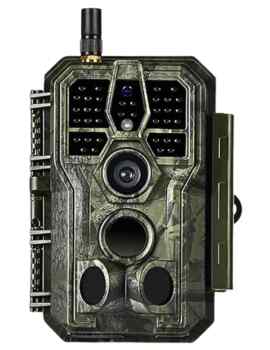
It is a good option for use in cold weather for a few key reasons:
- It has an IP66 weatherproof rating, meaning it is dust-tight and protected against heavy sprays of water. This makes it suitable for rain, snow, and temperature extremes from -4°F to 140°F.
- It has 36 no-glow infrared LEDs with a 100 ft range for night vision, allowing you to capture images in the dark even in frigid winter nights. The infrared flash is also invisible so it won’t scare animals.
- The A280W has a 0.1 second trigger speed to detect motion and take photos quickly before animals can move out of the frame. This helps in cold weather when animal movements may be slower.
- Easy mounting and camouflage color options make it simple to set up and blend into winter scenery. The sturdy build can withstand harsh elements.
- It captures 48MP images and 1296P HD video footage clearly in daylight or nighttime. The resolution and image quality stand up well despite cold temperatures.
5. Meidase S5 Trail Camera 48MP
The Meidase S5 Trail Camera uses Sony sensor technology, delivering ultra-crisp 48MP images and H.264 1080p or 1296p videos.
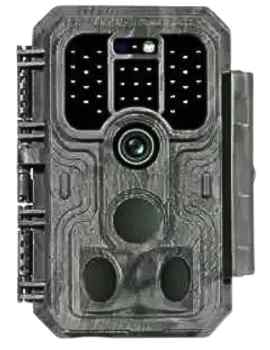
Perfect for outdoors, security, and nature enthusiasts alike. It is a good option for use in cold weather for a few key reasons:
- It has an IP66 waterproof rating, meaning it is protected against heavy sprays of water and dust. This makes it suitable for rain, snow, and temperature extremes typically found outdoors.
- It has upgraded infrared LEDs with 100ft night vision range, allowing you to capture clear images at night even in frigid winter temperatures when it gets dark early.
- The S5 has a super fast 0.1s trigger speed to detect motion and take photos quickly before animals can move out of the frame. This helps in cold weather when animal movements may be slower.
- It captures 48MP images and 1296P video footage clearly in daylight or nighttime. The resolution and Sony sensor provide excellent image quality despite cold temperatures.
- The intuitive interface, color screen preview, and supports up to 512GB SD card make it easy to set up and collect lots of crisp images over time.
6. Meidase P90 Pro Trail Camera
The Meidase P90 Pro Trail Camera. like Meidase S5, boasts a Sony sensor that snaps breathtaking 48MP images and H.264 1080p or 1296p videos.
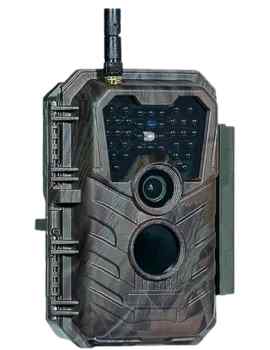
The Meidase P90 Pro trail camera is also a great option for use in cold weather conditions for a few key reasons:
- It has an IP66 waterproof rating, making it dust-tight and protected against heavy sprays of water. This allows it to withstand rain, snow, and temperature extremes often encountered when mounted outside.
- It features upgraded 36pcs 940nm infrared LEDs with a 75 ft night vision range. This allows the P90 Pro to capture clear black and white nighttime images even in dark winter conditions when game activity occurs.
- The super fast 0.2 second trigger speed allows the camera to detect motion and take photos rapidly before animals can move out of the frame. This helps counter slower movements in frigid temps.
- The P90 Pro captures 48MP images and records 1080P full HD video clearly both day and night. The quality allows discerning small details despite cold weather.
- The intuitive interface, 2.4” LCD screen, and support for up to 512GB SD cards make it simple to setup and collect lots of crisp images over time.
7. MAXDONE Trail Camera
Engineered for colder climes, MAXDONE Trail Camera captures astonishing 1520P 28MP images and 2.7k resolution videos, ensuring you never miss a moment with its 0.2s trigger time.
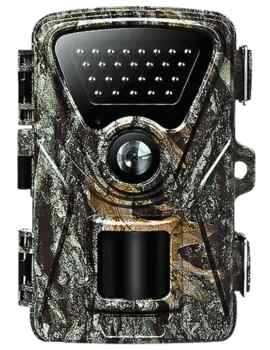
The MAXDONE PH820 trail camera is a great choice for use in cold weather conditions for a few key reasons:
- It has an IP66 weatherproof rating, meaning it is dust-tight and protected against heavy sprays of water. This makes it resistant to rain, snow, ice, etc. in harsh winter climates.
- It operates in a wide temperature range from -4°F to 140°F (-20°C to 60°C). The components and housing are designed to withstand extreme cold without any issues with things like the battery, LCD screen, or camera functions.
- The PH820 model has upgraded 850nm infrared LEDs that provide excellent night vision even when it’s dark early in the winter. The black & white night photos remain crisp and clear. “Hyper night vision mode” guarantees crystal-clear shots up to 65ft even in the dead of night.
- It has a quick trigger speed of 0.2 seconds to capture wildlife moving through the frame before they leave. This is important especially in cold when animals tend to move faster to conserve body heat.
8. Xtellar Trail Camera WiFi 32MP
The Xtellar Trail Camera provides unmatched clarity with 32MP images and 1296P HD videos, all powered by an advanced CMOS sensor and unique imaging algorithms.
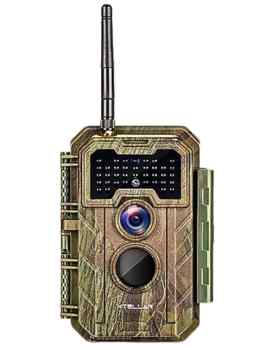
The Xtellar Trail Camera WiFi 32MP 1296P is a great choice for cold weather usage for the following reasons:
- It has an IP66 waterproof rating, making it resistant to rain, snow, dust, etc. This protects the internal components from moisture and extreme temperatures.
- It operates in temperatures ranging from -4°F to 140°F (-20°C to 60°C). The camera housing and electronics are designed to withstand freezing conditions and sub-zero temperatures.
- It has 36 high-power 940nm infrared LEDs with up to 90 feet of night vision range. Even in the dark winter months, it can capture crisp, clear black & white night vision images and video.
- The 32MP image resolution and 1296P video produce highly detailed photos and footage to see animals and objects clearly, even at a distance in poor lighting.
- It has a trigger speed of 0.2 seconds to quickly detect movement and capture images before the subject leaves the frame. This helps capture skittish animals in the winter.
- The WiFi connectivity allows you to remotely connect to it via smartphone to check the images, change settings, etc.
What are the Considerations for Selecting the Best Cold Weather Trail Camera?
1. Checking the Cold Weather Rating
This rating is very important if you plan to use your trail camera in cold winter conditions.
Most trail cameras have a cold weather rating somewhere in their specifications, usually listed as a temperature range. For example, a camera may be rated for use from -20°F to 120°F (-29°C to 49°C).
The cold weather rating tells you the lowest temperature the camera can operate reliably at before it may stop working or take lower quality images. Cameras with a very low cold weather rating, like -30°F or below, are best for very cold climates.
If a camera isn’t designed for cold temperatures, the battery performance, motion detector, and image quality can suffer in freezing weather. The components may even become damaged if they get too cold.
If the cold weather rating is not mentioned in the manual, or if there’s any ambiguity, always reach out to the manufacturer before making a purchase, especially if you are aware that your trail camera will be stationed in a cold weather location. Manufacturers have extensive data about their products, and a simple inquiry can provide clarity. I’ve found most brands responsive and helpful when it comes to pre-purchase queries.
Insurance and Warranty
While understanding the cold weather rating is pivotal, it’s also wise to investigate if the trail camera comes with any insurance or warranty coverage, especially against potential damages to its internal components due to extreme cold.
Such components can be expensive to replace, and having coverage can provide peace of mind. This is particularly important if you plan to station your camera in places with unpredictable weather patterns.
While trail cameras are robust tools designed to capture the magic of the wilderness, they are not immune to the challenges posed by cold weather. An informed decision, bolstered by a thorough reading of the manual and supplemented by manufacturer guidance, can make all the difference.
Always remember, a little extra effort upfront can save a lot of hassle down the line.
2. Battery Power for Trail Cameras: My Personal Experience with Lithium-ion vs. Alkaline
A few years ago, when setting up my trail cameras for the winter season, I faced the classic conundrum: which batteries to choose?
From all the options available, the two most frequently recommended were alkaline and lithium-ion. Little did I know how crucial this decision would turn out to be.
Alkaline Batteries
On my initial foray into winter trail photography, I opted for alkaline batteries. The science behind them is quite simple: they generate power through a chemical reaction between zinc and manganese oxide.
A crucial component in this process is the electrode, which is water-based. Now, I was aware of the basic science of water freezing in cold temperatures, but I hadn’t connected the dots.
As temperatures dropped, the water-based electrodes began to freeze. The precharge of these batteries starts at 1.5v, but as they’re consumed, their output diminishes, impacting the camera’s performance. Everything, from nighttime flash to trigger speeds, became compromised.
One chilling morning, to my horror, I discovered that several batteries had cracked, leaking corrosive chemicals. I could see the havoc they wreaked on my trail camera’s internal components. It was a disastrous combination and a lesson learned the hard way.
Lithium-ion
Based on the bitter experience with alkaline batteries, I decided to give lithium-ion batteries a shot the following winter. What I observed was a complete game changer.
Lithium-ion batteries maintained a consistent output of around 1.7v, as opposed to the gradually decreasing output of alkalines. This meant my camera received stable power throughout the entire life cycle of the battery.
The benefits didn’t end there. Lithium-ion batteries stood undefeated even in the most extreme cold temperatures. Whether it was a light frost or a biting cold of -40 F, these batteries never wavered.
Pro Tip – Don’t mix old and new batteries as well as battery types. It will cause issues.
For those looking to use trail cameras during winter, lithium-ion batteries are indispensable. The upfront cost might be slightly higher than alkaline, but the longevity and consistent performance make them well worth the investment.
To sum it up, if you’re passionate about trail photography and don’t want cold weather to play spoilsport, always, always opt for lithium-ion batteries. It’s a choice you won’t regret!
3. Trigger Speed, Recovery Time, and Detection Range: The Winter’s Impact on Trail Cameras
Winter brings along a unique set of challenges for trail cameras, and my journey with them has taught me some invaluable lessons. When it comes to capturing those fleeting moments of wildlife in the frigid outdoors, three factors play a decisive role: trigger speed, recovery time, and detection range.
Trigger Speed
This refers to the time taken by the camera to snap a photo once motion is detected.
In colder temperatures, the electrical components and batteries in some trail cameras can slow down, potentially causing a lag in trigger speed.
On one freezing morning, I remember waiting eagerly to review my camera’s captures, only to find that I had missed several deer crossings. The culprit? A slower trigger speed aggravated by the cold.
It’s paramount to check the camera’s specs for cold-weather performance to avoid such disappointments.
Recovery Time
After a trail camera takes a picture or series of pictures, it requires a certain amount of time to be ready for the next shot. Cold weather can extend this time, especially if the batteries are affected by the temperature.
If the recovery time is too long in freezing conditions, the trail camera could miss capturing additional photos of animals that walk by or enter the detection zone while it’s still processing. A recovery time of 1-2 seconds is ideal. But if it’s 5 seconds or more in cold weather, you risk missing shots.
My personal experience? I once placed two cameras side by side, one with alkaline batteries and the other with lithium-ion. Post a flurry of activity by a fox, the lithium-powered camera had several shots in succession, while the alkaline one had notable gaps between shots.
Lesson learned: ensure your camera has a robust recovery rate, and couple it with the right battery for cold conditions.
Detection Range
The camera’s ability to sense movement is crucial. Colder environments can sometimes affect the sensitivity of the camera’s motion sensors, reducing its detection range. The range may not be as far in freezing temps compared to warmer weather.
I recall a specific instance when my camera, placed in a frost-covered area, failed to trigger for animals that were slightly farther away, even though it worked perfectly during the warmer months. This taught me the importance of checking for any details related to a camera’s performance in colder temperatures.
Cold Weather Tips for Trail Camera Enthusiasts
Battery Recommendations
In my years of trail camera experience, one constant has been the superiority of lithium-ion batteries in cold weather. They perform significantly better in cold compared to alkaline batteries. Invest in quality lithium batteries like Energizer Ultimate Lithium or Duracell Quantum.
You can also consider using an external battery pack as a backup or primary power source, especially for extended deployments. Wrap it in insulation to slow down discharge. Use foam pipe insulation or reflective heat tape around the battery compartment to retain heat.
SD Card Management:
The importance of redundancy cannot be overstated. On one chilly outing, my SD card malfunctioned due to the cold, leaving me without footage of a rare snowy owl sighting. Had I had a backup, the story would’ve been different. Hence, my golden rule: two SD cards per camera. This way, if one card fails or fills up, you can quickly swap and continue capturing those irreplaceable moments.
Mounting
Use a metal mounting bracket instead of straps: Metal won’t get stiff and brittle like straps can in extreme cold. It will hold your camera steady.
Location
Location is everything. As the weather and food sources change, animal behavior changes too. Moving trail cameras to new locations during the winter months can result in more pictures. Look for bedding areas near water and food sources.
Find unique locations such as a fox den, a log crossing over a stream, or a carcass in the woods to capture interesting images.
Point the camera north/northeast: This takes advantage of ambient warmth from sunlight as temperatures drop each night. Avoid shaded southern exposures.
Insulation
Use zip ties or electrical tape: Secure doors, latches, and connectors that might pop open in the cold. Prevent moisture from getting places it shouldn’t
Put hand/feet warmers inside the camera housing: Tape them to the backside of the camera, out of view. This can keep the camera components 5-10 degrees warmer
Wrap camera in camouflage insulating wrap: Special camo neoprene wraps help insulate cameras in cold temps. Bonus if you can still access the controls.
Strap chemical hand warmers to the tree behind the camera: Redirect some warmth towards the camera housing. Position out of camera view.
Place a plastic baggie or electrical tape over LCD display: Protect your display from freezing rain and snow build up.
Testing Your Trail Camera:
Before investing hours in the cold, it’s essential to know if your camera is up for the task. A tip I picked up from a fellow enthusiast involves the household freezer.
Pop your camera (with the lithium-ion batteries) inside for a bit and then test its functionality. It’s a nifty way to check your camera’s cold tolerance.
I did this before a particularly cold expedition, and to my surprise, one of my older cameras faltered, saving me potential disappointment on the field.
Wrapping Up
In the ever-evolving world of trail cameras, cold weather conditions pose unique challenges. Whether you’re an outdoor enthusiast searching for the best night vision, a homeowner prioritizing home security, or a wildlife watcher valuing image quality, our comprehensive reviews have got you covered.
If you found this insight into the best trail camera for cold weather beneficial, don’t miss out on our upcoming blog! Dive into “Exploring the 12 Best Trail Cameras for Security in 2023” and unravel how features like HD video, long battery life, and cellular trail connectivity can redefine your trail camera experience.
From Spartan to GardePro, from inclement weather resilience to camera lens precision, we help you choose the right trail camera to stay active through the cold. So, don’t wait, gear up, and make every capture count!
FAQs
Q: What is the best trail cam to use in cold weather?
A: There are several high-quality cold weather trail cameras on the market. The best one is often subject to personal preference and specific needs. However, one of the strongest contenders is the “Vikeri 4K 32MP Trail Camera” known for its impressive picture quality, fast trigger time and ability to withstand harsh weather conditions.
Q: Does a cellular trail camera work well in cold climates?
A: Yes, several cellular trail cameras are designed to withstand extreme temperatures and perform excellently in cold weather. It is recommended to ensure that the camera also has a good battery life or associated solar panel accessory to cope with reduced sunlight hours in winter.
Q: What is a notable feature of the best trail game camera for cold weather?
A: The best trail game camera for cold weather would pack high video resolution and infrared vision for nighttime. It would also be rated for its ability to operate in low temperatures without compromising picture quality or operation speed.
Q: Is investing in a trail camera for cold weather worth the cost?
A: Yes, investing in a trail camera designed to withstand cold weather can be worth the price for many users. These cameras use advanced technology to function effectively in lower temperatures, providing high-quality and reliable performance that less expensive trail cameras could fail to offer.
Q: How does a trail cam capture images at nighttime in cold weather?
A: Many trail cameras are designed with infrared technology to take clear photos and videos at nighttime, even in cold weather. This infrared system detects motion in its field of view, triggering the camera to capture the image or start recording a video.
Q: Looking for a trail camera that can handle cold weather, what should I consider?
A: When looking for a trail camera for cold weather, consider factors like its range, trigger time, picture quality, video mode, and of course, durability in cold temperatures. Brands like GardePro and Spartan are known for producing high-quality cold weather trail cameras.
Q: What is the best night trail game camera for cold weather?
A: The Meidase P90 Pro Trail Camera 48MP is one of the best night trail game cameras for use in cold weather. It has an excellent nighttime capture feature owing to its superior infrared technology and fast trigger time, providing crystal-clear photos and videos irrespective of the weather conditions.
Q: Can you provide an example of a top-rated cellular trail camera for harsh climates?
A: One of the best cellular trail cameras suitable for harsh climates is the “Spartan Gocam 4G LTE Trail Camera”. It offers high-resolution photo and video capture, easy setup, and a robust build designed to withstand extreme weather conditions.
Q: How to set up the camera for use in cold weather?
A: Setting up a trail camera for use in cold weather does not differ much from a regular setup. However, due to the cold conditions, make sure the batteries are fully charged, and the camera is sealed properly to prevent moisture. Some cameras also come with a solar panel which can be useful in maintaining battery power throughout winter.
Q: What is the best trail camera overall for cold weather?
A: The Vikeri 4K 32MP Trail Camera and MAXDONE Trail Camera Hunting Camera Game are often considered the best trail camera overall for cold weather. With its excellent photo and video resolution, quick trigger time, infrared night vision, and sturdy design, it’s built to deliver reliable performance in extreme conditions. It’s a worthwhile investment for wildlife tracking in cold weather.


